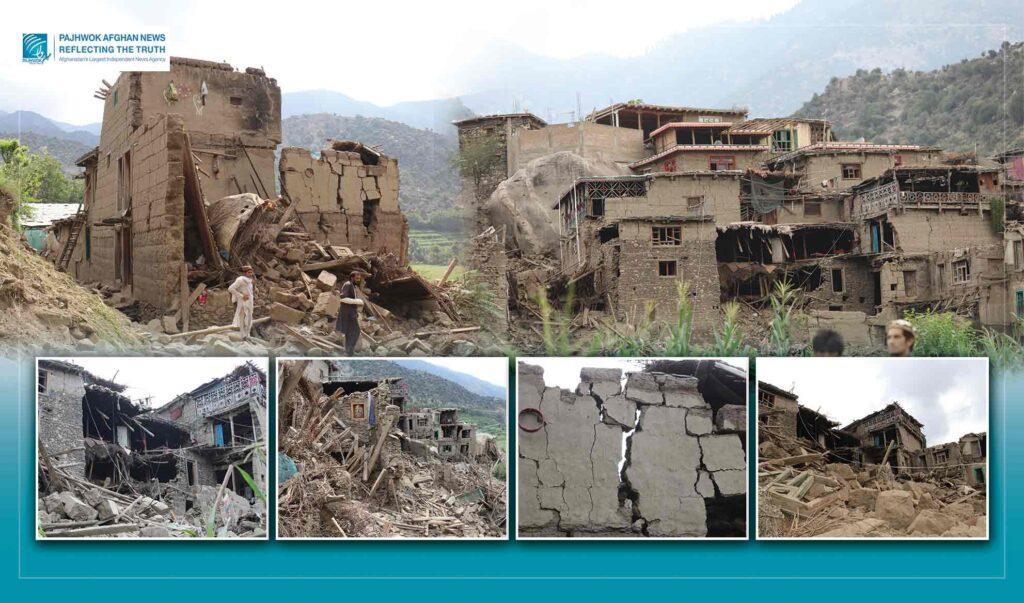Why The Kunar Earthquake Was So Deadly?
KABUL (Pajhwok): According to analysts and those affected, the earthquake in eastern Kunar was deadly because it was shallow and many houses that got destroyed were built of stones in non-standard ways on the slopes of mountains. The earthquake occurred when people were asleep. In some areas, the lack of roads also hindered rescue operations.
On August 31 , around midnight, an earthquake struck Kunar, Nangarhar, Laghman, Panjshir and Nuristan provinces.
According to the Global Disaster Alert and Coordination System (GDACS), the earthquake measured 6.0 on the Richter scale and had a depth of eight kilometers.
Some sources reported a depth of up to 10 kilometers and a magnitude of 6.2. The epicenter was reported in Nurgal district of Kunar, where the most damage occurred.
According to government figures, the earthquake killed 2,205 people and injured 3,640 in Kunar; 12 people died and 255 were injured in Nangarhar and 80 people were injured in Laghman. Reports indicate that 6,782 houses were destroyed.
Why was the quake so deadly, destructive?
Residents of Kunar said they were in deep sleep when the sudden and severe earthquake struck.
Sayed Akbar, a resident of Titak village in Nurgal district, said:“It was around midnight, we were asleep when the earthquake struck. Before we could get out of our beds, people fell, some were hit by falling stones from above, and I myself was injured along with my wife when a stone fell on us. My wife's leg was broken, and I was injured too.”
He explained that in these areas, most houses were built with stones, clay and wood on mountain slopes due to limited flat land.
Akbar said the lack of roads in many earthquake-affected areas contributed to the high death toll because timely medical assistance was not possible.
He added:“If roads were built and proper materials like cement were used in house construction, it would have been better. Previously, we just stacked stones on top of each other, which collapsed during the earthquake and caused destruction.”
Another resident, Noorafzal, injured in the earthquake and now hospitalized in Nangarhar, described the terrifying moments:“It was between 10:50 and 11:50 PM. The ground shook violently, houses collapsed, the earth moved and stones rolled down from the mountains. It was a terrible situation.”
He also cited the non-standard construction of houses on mountain slopes, the use of weak materials and the lack of roads as main reasons behind the high casualties and damages.
The Ministry of Defense conducted rescue operations using helicopters and commandos were deployed to areas where helicopters could not land.
Noorafzal emphasized that residents need urgent help, but first proper houses should be built.
Impact of earthquake intensity, depth and house construction
Seismologist Dr. Zakaria Shinezai said that accurate earthquake prediction is currently impossible. However, some early-warning systems can provide a few seconds' notice.
According to the US Geological Survey (USGS ), earthquakes can have depths of up to 800 kilometers. The intensity decreases with distance from the epicenter.
Shinezai added:“The shallower the earthquake, the greater the damage. A shallow earthquake transfers its energy directly to the surface, while a deep earthquake's energy is absorbed in the Earth's layers, causing less surface damage. In Afghanistan, houses built on mountainsides are more vulnerable because landslides and falling stones can destroy them. Non-standard or poorly built houses collapse more easily than properly constructed ones.”
He concluded that the Kunar earthquake was more deadly than others because it was shallow (around 10 km), many houses were non-standard and weak and the area was mountainous and some houses were built very close to each other, causing a chain collapse.
Hafiz Mohammad Yousuf Hamad, spokesperson for the National Disaster Management Authority (ANDMA), said investigations are ongoing, but the primary causes of fatalities were non-standard construction of houses and lack of public awareness.
Solutions
Seismologist Dr. Zakaria Shinezai said many people in Afghanistan are economically disadvantaged, thus unable to afford building concrete houses.
According to him, even if people build simple houses, they should not be heavy, wooden beams should be connected properly within the structure, and houses should be built on flat land to minimize damage from earthquakes.
Shinezai added that people should be made aware of selecting proper locations when constructing houses and always maintain preparedness, as earthquakes can occur at any time in Afghanistan.
He also noted that Afghanistan is a seismically active region, with earthquakes possible at any time.
Hafiz Mohammad Yousuf Hamad, spokesperson for the National Disaster Management Authority (ANDMA), said:“Our agency has previously and continues to send teams to village by village and district by district to educate people about earthquakes, floods, and other natural disasters. Unfortunately, people often do not pay attention, and when such events occur, they suffer casualties as a result.”
According to Hamad, ANDMA plans to further increase public awareness about natural disasters.
He also stated that surveys are currently underway in earthquake-affected areas to rebuild houses according to proper construction standards.
He added that the agency has so far registered 7,000 houses that were fully or partially destroyed, but after the survey, it will be determined how many need to be rebuilt completely and how many will be repaired.
According to him, ANDMA has also identified 6,500 high-risk areas across the country for preventive measures against natural disasters, where projects such as bridges, retaining walls, and other safety measures will be implemented.
Hamad said that various committees have been established to organize and distribute aid to earthquake-affected people, with assistance provided both locally and internationally.
However, exact numbers are not yet available because the aid is still being coordinated among multiple agencies and committees.
Previous quakes in Paktia and Herat
In June 2022 , a strong earthquake struck Barmal, Giyan, and Zerak districts in Paktika and the Spira district in Khost, killing around 1,000 people, injuring about 3,000, and destroying around 10,000 houses fully or partially.
In October 2023 , Herat experienced a 6.2-magnitude earthquake, causing heavy casualties and damage. The government reported over 2,000 affected people, with the greatest damage in Zinda Jan and Ghurian districts, and 1,320 houses were destroyed.
sa/ma

Legal Disclaimer:
MENAFN provides the
information “as is” without warranty of any kind. We do not accept
any responsibility or liability for the accuracy, content, images,
videos, licenses, completeness, legality, or reliability of the information
contained in this article. If you have any complaints or copyright
issues related to this article, kindly contact the provider above.
Most popular stories
Market Research

- Zebu Live 2025 Welcomes Coinbase, Solana, And Other Leaders Together For UK's Biggest Web3 Summit
- Yield Basis Nears Mainnet Launch As Curve DAO Votes On Crvusd Proposal
- Blueberry Launches A Bold New Brand Platform
- Stonehaven Circle Marks 13Th Anniversary With Hadrian Colwyn Leading Calvio Ailegacyx Innovation
- R0AR Launches Buyback Vault: Bringing 1R0R To R0AR Chain Unlocks New Incentives
- Moonbirds And Azuki IP Coming To Verse8 As AI-Native Game Platform Integrates With Story





















Comments
No comment